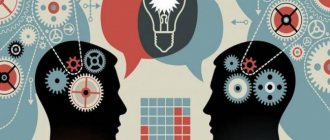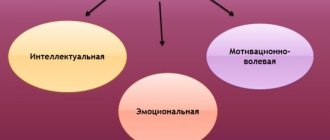Perceptual actions: what are they?
Perception, or perception, is a person’s ability to reflect surrounding objects and situations. Based on the data obtained in the process of perception, knowledge of the surrounding reality is carried out and an individual (subjective) understanding of it is formed.
Each person is unique, which is why human culture and art are so diverse. However, despite differences in perception, each person goes through certain stages in his development, which are accompanied by the implementation of specific actions. These actions were studied and called perceptual.
Perceptual actions are included in the structure of the perception process and the structure of human activity. Perception is an active process, so it is inextricably linked with activity. From a very early age, a person performs actions aimed at cognition and learning. After all, in order to live in this world, he needs to know this world and be able to interact with it.
The nature of the perception process
The external environment and its individual objects and phenomena influence the senses through analyzers. Their complex interaction ensures the flow of information into the brain centers and its processing.
Complex analysis and synthesis of external data ensure the creation of a holistic image: external and hidden, internal properties and qualities of the object are determined. That is, a number of its characteristics are formed.
The process of perceiving the same object is unique, as is its mental image, since they depend on the individual mental and physiological characteristics of a person. Life principles, views, motives, interests, preferences as the results of upbringing and lifestyle certainly determine the assessment of the properties and qualities of an object. For example, the same work of art can be emotionally assessed by different observers as “strikingly beautiful” and… “disgusting.”
Stages of formation and development
The formation of perceptual actions occurs during the learning process. Their development is divided into three stages.
At the first stage, the formation of perceptual action itself occurs, which begins with the child performing practical actions with unfamiliar objects. As a result, the formation of perceptual tasks occurs - the formation of an adequate image of an object, which subsequently becomes a sensory standard.
At the second stage, a restructuring of sensory processes (occurring in the sense organs) occurs, which become perceptual actions under the influence of practical activities. Actions are carried out with the help of receptor apparatus (tactile and visual), children become familiar with the spatial properties of objects.
At the third stage, the process of reducing and curtailing external actions occurs. They become hidden, occurring at the level of consciousness and subconscious. The external process of perception becomes an act of instantaneous discretion.
By this time, the child has formed a system of sensory standards (socially developed systems of sensory qualities, for example, a system of geometric shapes, etc.). Thanks to them, sensory-perceptual actions change. They turn from a process of image construction into a process of identification.
Meaning of Perception
The sense organs are conductors and intermediaries between man and the outside world. It is they (visual, auditory, olfactory, tactile, gustatory) that provide a holistic perception of the environment, receiving irritant signals on the receptor surfaces. As a result, a person receives a complete understanding of objects and phenomena, their properties and qualities, and builds his “relationships” with them.
In addition to sensations, the perception of the world is provided by thinking, speech, memory, therefore the perceptual activity of an individual is a complex cumulative process that depends on many individual properties of his psyche.
Levels
Perceptual action can be divided into four levels:
- detection (characterized by the detection of a stimulus);
- discrimination (at this level perception occurs with the subsequent formation of a perceptual image);
- comparison or identification (at this level, the perceived object is identified with the image that is stored in memory; or several objects are compared);
- identification (the corresponding standard is extracted from memory and the object is categorized).
Game and development
Perceptual actions in preschoolers are a fruitful connection between the actions of orientation and exploration with the actions of execution. And the unity of visual and manual actions ensures the accuracy of perceptual analysis.
Children learn about the world around them through play. While playing, they actively process and assimilate new information. Thus, they accept social norms and rules for successful adaptation in society.
In preschool children, the following types of perceptual actions are distinguished:
- identification actions (object identification);
- actions in relation to the standard (comparing the properties of the object with the standard);
- modeling the actions of perception (by mastering productive activities, the child learns to create new objects: modeling, drawing, inventing).
Perceptual systems
In the process of activity, a person constantly needs to solve some problems that require the perception of the most adequate reflection of the situation. Human perceptual systems are designed to solve these problems. These include:
- visual system;
- auditory;
- musculocutaneous;
- olfactory-gustatory;
- vestibular.
All of them provide the brain with the necessary information, which is used for the normal functioning and development of a person, both physically and mentally.
Mechanisms of social perception that facilitate mutual understanding
Next, let's talk about the basic mechanisms of the perceptual side of social communication.
Reflection
- this is the name of an individual’s ability to conduct self-analysis in order to find out how the interlocutor perceives him. When participating in the process of social communication, it is important for any person to understand how the opponent sees him, what opinion he formed, what impact the words had.
Identification
– with the help of this mechanism, it becomes possible to put yourself in the place of your interlocutor in order to try on his point of view. In this way, full or partial acceptance of the partner’s views and opinions occurs.
Empathy
– it lies in the ability to experience genuine sympathy and empathy for another person. It is based on absolute understanding and acceptance of the emotions and internal experiences of the interlocutor.
Attraction
– such a mechanism of perception is based on an already formed positive impression of a person. Positive emotions contribute to the development of friendship, affection, and love. You can achieve attraction if you have similar interests, values, opinions, etc.
Human sensory-perceptual system
Sensory processes are sensations. A person constantly feels the influence of the external world on his body: he sees, hears, smells and tastes, feels tactile and temperature effects on his body. It also senses processes occurring inside the body: hunger, pain, excitement or weakness, etc.
The sensory-perceptual system is constantly developing and improving in the process of human life. This is necessary for a person’s successful adaptation to the outside world. A person’s abilities and capabilities depend on the quality of the perception system.
This is especially noticeable when compared with people who have disturbances in the development of perception. The life of a person with disabilities (blindness, deafness, muteness, etc.) differs from the life of an absolutely healthy person. Perceptual actions play a significant role here: the more minor the perception defect, the easier it is to correct and possibly correct it. This is done by specialists - defectologists.
Manifestations in relationships with others
All people have different perceptual abilities. This depends, in part, on genetics and culture. This quality can also be developed, which is especially important for people whose work is related to communication and teaching. For example, the perceptual abilities of a teacher are the skills of observation, to find an individual approach to each student, regardless of his academic performance, character, or nationality. In relationships with others, perceptive individuals demonstrate a high level of empathy - emotional empathy for the interlocutor.
A person with a high level of development of sensory perception easily finds a common language with others
The importance of the perception system for humans
Scientists have been studying higher mental functions of humans (thinking, memory, voluntary action) for many years. The relationship between the system of perception and activity and the development of human thinking has been proven. In turn, thinking has a significant impact on a person’s condition, his abilities and capabilities. Perception is one of the highest mental functions of a person.
In order to live, a person needs to constantly reflect the surrounding reality and respond to the perceived information. Perception provides an individual and at the same time adequate reflection of reality. This is especially important for solving perceptual problems. Perceptual actions in the process of perception play an important role; they ensure the full development of the human psyche.
Simply put, to be healthy and happy, a person needs to be involved in some kind of activity. The brain is designed in such a way that it constantly needs to process and assimilate new information, otherwise it begins to become “lazy.” And a “lazy brain” is the first step to the development of dementia.
Properties of perception
Perception ensures the functioning of various mental processes.
The perception of an object as a specific image, regardless of its location, provides such a property of perception as objectivity.
Simultaneously with the perception of an image (natural or, for example, drawn), its properties are also reproduced in consciousness.
- Such a property as integrity is expressed in the fact that an object is recognized regardless of whether all its parts are present, whether they are distorted, or whether their location in the object is incorrect.
- The meaningfulness of perception during the normal functioning of the human psyche can be traced in the fact that the observed object is correlated with a specific class, category (classified).
- Observed objects (or situations) are perceived as unchanged, even if the conditions of their demonstration change. So, for example, by feeling an object in complete darkness, a person can correctly determine what it is and name its main characteristics. This property of perceptual activity is called constancy.
- This property of perception, such as structure, allows you to perceive the environment reliably, even if sensations are not connected. The expression “glass surface of a lake” paints a specific image of a perfectly smooth, shiny, bluish-greenish surface of a reservoir.
- The individual state of mind necessarily influences perception: stormy weather delights some, but frightens others immensely and creates a state of panic. This property of perception is called apperception.
- Perception depends on the conditions in which it occurs. The perception of the same thunderstorm in a real situation and, for example, when watching a movie, will occur differently, which is where such a property of perception as contextuality manifests itself.
The influence of cultural and historical experience on a person
Modern people are so accustomed to freely receiving any information that they don’t even think about the fact that this is the result of the activities of a huge number of people. Their contribution to the development of modern society is enormous. Everything that a person can and knows is not only his merit, but also the property of society as a whole.
Perception is a system of perceptual actions, mastery of which occurs in the process of special training and practice. A child can master sensory standards only with the help of an adult who guides him and helps him identify the most significant features of objects and situations. This is very important for analyzing reality and systematizing the child’s personal sensory experience.
There are cases where children were deprived of communication with their own kind. These are the so-called “children of Mowgli”, raised by animals. Even after returning them to human society, it was rarely possible to adapt them to human society.
Does an adult have perceptual activity?
Since perceptual actions are actions of learning and cognition, it may seem that they are unique to childhood. However, this is not so: every time an adult learns something new (a hobby, a new profession, foreign languages, etc.), a system of perceptual actions is activated, which helps to quickly master new knowledge and skills.
Man is a unique creature, his possibilities are limitless, and all this is thanks to consciousness and psyche. It is they who distinguish man from all life on the planet. Only a person is capable of voluntarily regulating his activities in accordance with his desires. Human activity is not chaotic and unsystematic, but is part of the structure of consciousness and thinking. Until now, scientists all over the world are studying the human psyche, making new discoveries, but it still remains a mystery.









